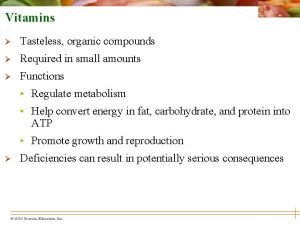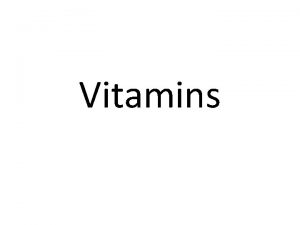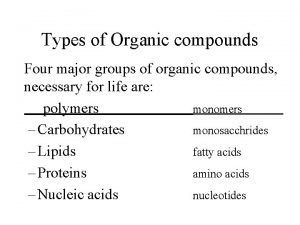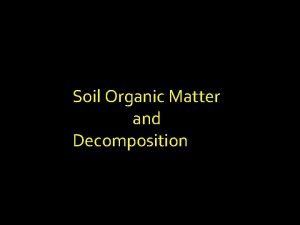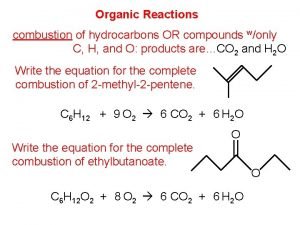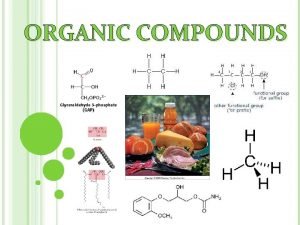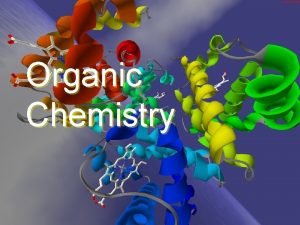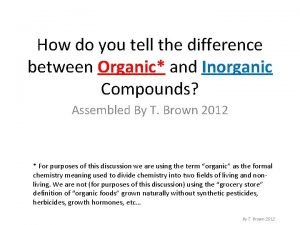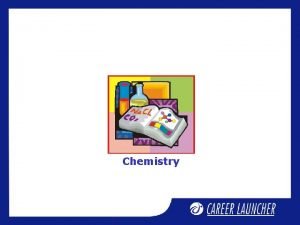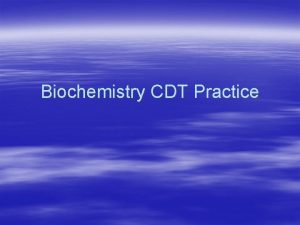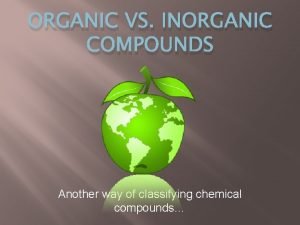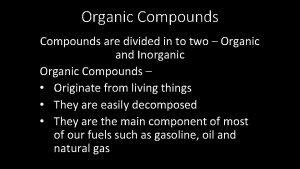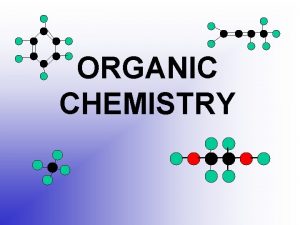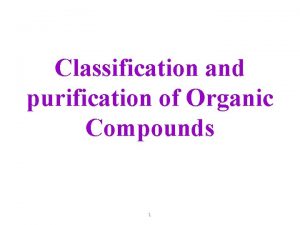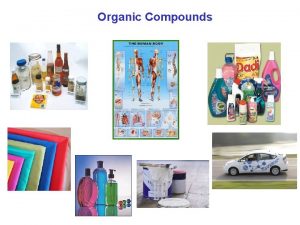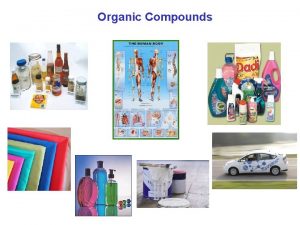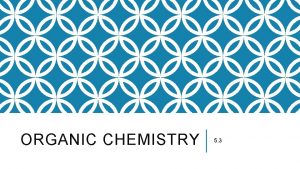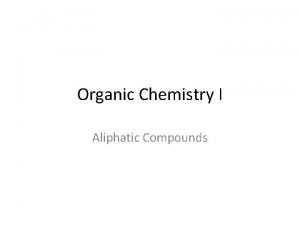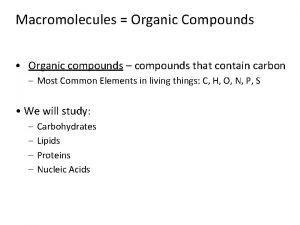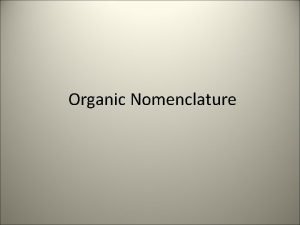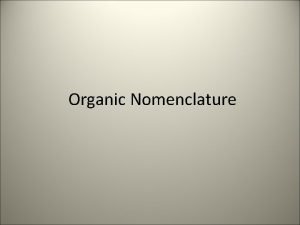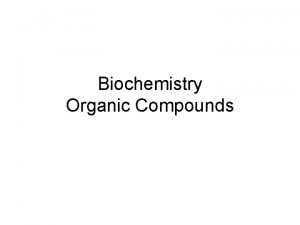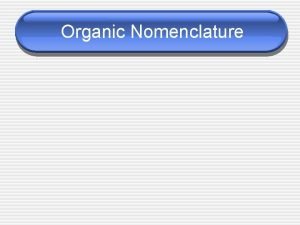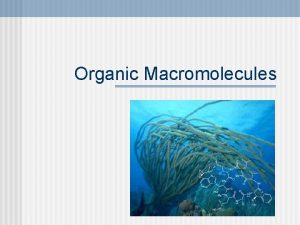Organic Compounds Chemistry Joke Q What did one



















- Slides: 19

Organic Compounds

Chemistry Joke Q: What did one charged atom say to the other? A: I’ve got my “ion” you!!!

Organic Molecules Generally, molecules that contain carbon are organic Some exceptions are carbonates (CO 32 -), cyanides (CN-), simple oxides of carbon (CO), as well as diamond and graphite Diamond and graphite are allotropes of carbon— that is, they are both carbon, but in very different structural forms.

Organic Molecules / Hydrocarbons are organic molecules that contain only carbon and hydrogen. Methane, CH 4, is the simplest hydrocarbon.

Organic Molecules Other organic molecules may contain many other elements including halogens, metals, sulfur, oxygen, phosphorus, or nitrogen.

Organic Compounds Organic compounds make up the whole or part of innumerable products—some natural and some synthetic. Plastics Explosives Paints Petrochemicals-derived from petroleum, but are used to make synthetics such as plastic

Organic Compounds Foods Starch, sugar, caffeine Biological Compounds Amino acids, Proteins, DNA, RNA, cellulose, hormones, cholesterol Pharmaceuticals aspirin, vitamins, insulin

Structure Organic molecules are constructed as carbon atoms form 4 stable, covalent bonds.

Structure These carbon structures can have single, double, or triple bonds. They can be straight chains or chains with branches. They can also form rings.

Alkanes: Saturated Hydrocarbons Remember: Hydrocarbons are molecules composed of C & H. Each carbon atom forms 4 chemical bonds A saturated hydrocarbon is one where all C - C bonds are “single” bonds & the molecule contains the maximum number of H-atoms. Saturated hydrocarbons are called ALKANES

Alkenes and Alkynes Alkenes contain a double bond between adjacent carbon atoms. Alkynes contain a triple bond. • These hydrocarbons are called unsaturated because all of the bonds are NOT single bonds. Copyright © 2005 by Pearson Education, Inc. Publishing as Benjamin Cummings 11

Functional Groups Carbon atoms bound to each other form a backbone to which other atoms or groups of atoms are attached. These groups of atoms are called functional groups. Aldehyde group

Build the Structure Compound CH 4 (methane) CH 3 CH 2 OH (ethanol) C 2 H 6 (ethane) CH 2 O (formaldehyde) C 2 H 4 (ethene) C 6 H 6 (benzene) C 2 H 2 (acetylene) CH 3 COOH (acetic acid) Structure

Structure CH 4 Methane C 2 H 6 Ethane C 2 H 4 Ethene C 2 H 2 Acetylene CH 3 CH 2 OH Ethanol CH 2 O Formaldehyde C 6 H 6 Benzene CH 3 COOH Acetic Acid

Structure / Polymers When organic molecules form long chains with repeating structural units, they are called polymers. These chains are flexible—the bonds in the backbone can swivel like paperclips hooked together.

Structure / Polymers can be natural or synthetic Proteins, cellulose, RNA, amino acids and DNA are examples of natural organic polymers. Plastic, nylon, and Kevlar are examples of synthetic organic polymers. Insulin (a protein)

Polymers Rubber

Properties of Organic Compounds Covalent bonds Low melting and boiling points Often liquids or gases at room temperature and pressure

Chemistry Joke Q: What did the bartender say when oxygen, hydrogen, sulfur, sodium, and phosphorus walked in? A: OH SNa. P!!!
 In iupac naming priority order
In iupac naming priority order Ib organic chemistry functional groups
Ib organic chemistry functional groups Inorganic vs organic chemistry
Inorganic vs organic chemistry Where vitamins are absorbed
Where vitamins are absorbed Vitamin flowchart
Vitamin flowchart Types of organic compound
Types of organic compound Decomposition of organic matter equation
Decomposition of organic matter equation Charring test of organic and inorganic compounds
Charring test of organic and inorganic compounds Combustion of pentene
Combustion of pentene Hagfish slime macromolecule
Hagfish slime macromolecule All organic compounds must contain the element
All organic compounds must contain the element Organic compounds must contain:
Organic compounds must contain: Introduction to organic chemistry
Introduction to organic chemistry Whats the difference between organic and inorganic
Whats the difference between organic and inorganic Purification and characterization of organic compounds
Purification and characterization of organic compounds Organic compounds such as proteins and starches are too
Organic compounds such as proteins and starches are too Organic vs inorganic compounds
Organic vs inorganic compounds What is the classification of organic compounds
What is the classification of organic compounds Carbon compound
Carbon compound Principle of simple distillation
Principle of simple distillation



